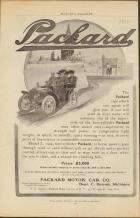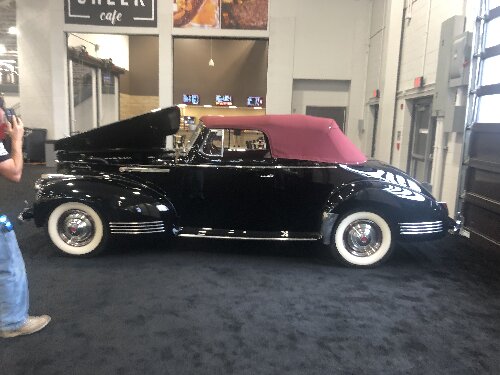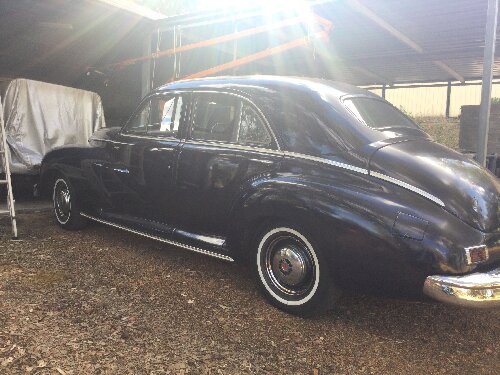|
Re: 1940 Horn ring
|
||||
|---|---|---|---|---|
|
Home away from home

|
Dear ALM:
Originally the plastic piece was a press fit into the hub. Over time the plastic distorts and the button ends up held in place by the spring. The horn ring flexes on those little cams which deflects the corresponding inner flat into contact with the copper contact. The plastic parts looked great when new, but rapidly deteriorated. I remember when, before you could get reproduction parts, almost every 18th-20th series Packard dashboard and interior parts looked like crap. The only one I can remember that looked good was an 18th series 180 limo that sat idle in a heated New York City garage with under 9,000 miles on it. That car was still new and the plastic looked fantastic. And boy, it drove like a million bucks. Driving that car was an education in all the wearing points that cannot be restored.
Posted on: 2012/1/6 19:47
|
|||
|
||||
|
Re: 55 sparkplug boots w/ ribs where?
|
||||
|---|---|---|---|---|
|
Home away from home

|
I think if you buy the non-covered wire set with bent connectors from Dwight Heinmuller you can slide the Steele product over the connector with the use of dielectric silicone grease.
It won't look molded until the heat from the motor vulcanizes the rubber some. Sound Okay?
Posted on: 2012/1/6 19:21
|
|||
|
||||
|
Re: 37 120 Dashboard removal
|
||||
|---|---|---|---|---|
|
Home away from home

|
Dear rsvls:
Yes, from 1935 on the Packard dashboard is a pretty tough nut. However, the panels usually didn't require much attention during the planned for service life of the car. These cars had the dashboard assembled before the glass was installed. So they hooked up all the wires through the windshield. In fact for the Clipper - really a pain - the first page of the manual covers how to remove the windshield I presume to service the dashboard. Later service bulletins admitted it was a pain and advised making 10-32 studs to replace the original screws. Now for your car the dashboard will come off. Some of the fasteners are covered by upholstery. However, you may regret such an action because it is much easier to do with the steering gear removed and, I believe, the windshield has to come out as well. When they built the car they dropped the completed body onto the chassis and the installed the steering wheel. Putting dashboards in prior to windshield glass was pretty much standard industry practice from around 1935 forward. Some GMs will come out with the glass in place (putting them back is a nightmare), but Packard liked to put the screws under the windshield rubber. The above suggestion about seat removal and center panel removal are consistent with my experience and I will add that removing the glove box provides a means of access as well. Let me add as well that the careful application of penetrating oil a few days prior to service will make your life a lot easier. If you are using a conventional incandescent drop light, affix a piece of cardboard to the back of the reflector with zip ties to prevent burning yourself and any soft parts. Hope this helps, and take comfort in the fact that from 1938 forward Packard dashboards got progressively more difficult to service that your car.
Posted on: 2012/1/4 18:38
|
|||
|
||||
|
Re: 1934 1103 ELECTRICAL PROBLEM
|
||||
|---|---|---|---|---|
|
Home away from home

|
Hi Terry:
Good. We're making progress. Your results are consistent with the headlight switch diagram. The only purpose the third wire in the left side light socket serves is to secure the bus bar. It gets plugged into a dead end in the five hole bakelite headlight connector. As for the ground through the green wire when on "tilt" and "pass" as long as the bus bar is connecting pins 1 and 2 in the headlight socket that shouldn't matter because there is already a shorter path to ground in the headlight bulb. It may be that the column switch bridges the unused filaments in the 1 and 2 positions (that switch is like a clever question on an IQ test). Anyway, just take both headlight bulbs out and verify that the circuit becomes open. If you had a short circuit you would be burning out fuses like crazy (or the burned out left bulb is the only reason you weren't blowing fuses). If you want to be sure substitute a test light for the fuse and move the switch through the positions. It should glow or be dead, but if it suddenly burns brighter then you have a short in the harness or a wire hooked up wrong. To be sure, remove all bulbs and retest if you find a problem. Those special big fuses are available through MSC Industrial Supply and should be replaced anyway. Glad to hear that your three filament system is intact.
Posted on: 2012/1/1 10:33
|
|||
|
||||
|
Re: 1934 1103 ELECTRICAL PROBLEM
|
||||
|---|---|---|---|---|
|
Home away from home

|
Dear Traum...
Given you have an obvious harness problem, let me convey some notes I have on the socket wiring. I am 90% sure this is correct because I recorded it from a fairly pristine original headlight. a) Draw a circle with a notch at 6 o'clock position. b) Next draw three pins inside one at 6 o'clock, 10 o'clock, and 2 o'clock. c) Label these 1, 2, and 3 d) The wires for the right lamp are as follows: 1: Red 2: White 3: Green Now you can check your headlights consistent with Owen's switch diagram. Unfortunately I don't have iron clad notes for the left side because the I never came across a pristine headlight. As well, once the right lamp is set up correctly the bus bar position is determined by matching the right side "driving" position. However, the fact that your light still has the bar in it is a strong indication that is has never been tampered with. Many knowledgable people aren't even aware that it exists. From there you can use a test light at the switch and determine exactly what filaments are being switched on. Hope this helps.
Posted on: 2011/12/31 17:22
|
|||
|
||||
|
Re: 733 door sills
|
||||
|---|---|---|---|---|
|
Home away from home

|
I agree. I think they should be silk screened.
Posted on: 2011/12/31 15:59
|
|||
|
||||
|
Re: 1934 1103 ELECTRICAL PROBLEM
|
||||
|---|---|---|---|---|
|
Home away from home

|
Dear traum...
If you notice in Owen's light position sequence the right lamp uses three separate positions, while the left uses two. Now this translates into the following colloquialisms: a) park, b) city, c) pass, d) drive The novelty of this system is that the right headlight lense is cut to throw it's beam to the left, so it dips for passing oncoming cars. On the left side bulb socket there should be a bus bar connecting two filaments thus giving two light positions with three filaments. I think if that bus bar is in the wrong position it can divide the circuit the wrong way. The original bulb sockets were labelled 1 2 3 and I can't remember which two are connected except that I would assume City (or tilt) would be the same for both lamps, and thus, the bus bar connects the two remaining filaments. As for burning out bulbs I have been told by a well known authority that original bulbs benefit greatly from a careful application of super glue to secure the glass to the socket. If that is vibrating the bulb can be damaged. I would also check and make sure the voltage isn't spiking from a regulator problem, and the previously ground problem that may be causing pulsation fatigue. Nothing should be rattling or vibrating in those headlights. Hope this helps
Posted on: 2011/12/30 18:34
|
|||
|
||||
|
Re: Starter won't crank
|
||||
|---|---|---|---|---|
|
Home away from home

|
Dear Gearrat:
It sounds like you want to try to fix the thing if possible and so lets go through a few garage style methods: a) Go to Radio-Shack, Wal-mart, the hardware store or whatever and buy a cheap multi-meter. b) Take the brushes out. c) Now check the fields for short to ground (case) and for continuity between the brush side and the post side. d) Next set the multi-meter to DC voltage and connect the leads to the post side and the brush side of the field circuit. Next while holding a screwdriver near the pole shoe momentarily apply battery voltage to the field leads. The screwdriver should reflect strong magnetism and you should see a voltage show up on the meter. If you get nothing but battery voltage on the meter, the fields are open. If you get nothing but low voltage the fields are shorted to voltage. Either case will require some professional help. e) Next, take the multi-meter and test the armature circuits for continuity and shorts. You should find continuity between opposing bars on the armature. Next test for continuity between adjacent bars. If you find that you have some then the armature is shorted. f) next are the brushes. Test the brush plate for shorts and also replace the brushes if they are worn. Once I handled a Packard Twin Six where the problem was a loose wire in the brush. I fixed it with metallic epoxy. g) If you want your armature professionally tested, call around to find a place that has an "armature growler". they can drop your baby in that thing and test it for shorts. h) Finally, put the unit together without brushes and test for shorts between the armature and case and also that it spins free without hitting anything. Hope this helps and don't hesitate to contact a library for a manual on same.
Posted on: 2011/12/29 19:25
|
|||
|
||||
|
Re: Thoughts On Recruiting The Next Generation
|
||||
|---|---|---|---|---|
|
Home away from home

|
Wow! This thread is going to be a lot of fun!
I got interested in Packards because years ago the CCCA crowd threw fantastic parties. They even carried little martini bars that were set up on the running board. In those days the drinking age was 18 and the BAL .15%. So you could get pretty stoned and still be legal. Of course there was less traffic on the roads too. And I was never a really big drinker, but a good party is hard to turn down. Today incomes are falling, asset values are falling, and tax revenues are falling so expensive hobbies like old cars are subject to retrenchment. Also, the industrial base is a shambles and little services are disappearing as well. Not to mention that certain specialists are not being replaced. I agree as well that education is a wasteland. I made a living as a practicing mathematician for 20 years. Work and interest in that technology became harder and harder to sell until the bottom fell out. During that period the corporate foundation changed from value added based profits to some screwy political system of self-centered communication schemes whereby nonproductive and counter productive aggressives systematically got rid of people who went to work to actually do something. At least the Vanderbilts had a railroad. Today we have junk like twitter and fortunes based on pure baloney. I think the biggest problem though is that back in the 1960's if you got behind the wheel of a good Packard, it drove better than a brand new Chevrolet. You can't say that today. Also, when I was a kid a blue collar tradesman could earn enough money to live well and have a car as a hobby. Those days are gone. Supposedly if you earn $16 dollars an hour you are even with the people building the Model T. And they didn't have to pay as much in taxes. Today car mechanics are making less than 50% what they did 15 years ago and being chiseled by flat rate as well. I would never expect any youth to put up with that. Old people like me know how to put up with hard times which is why the average age for skilled automotive service is over 50. It's fortunate that the cars today are so much better because in a few years the automobile will become like the PC - something used until it breaks and thrown away. Really, the car companies treat their service professionals like - shxt - and are systematically starving the technicians into oblivion. Why would any young person want to put up with that? I don't blame them one bit. The system today is geared to reward bxllshxtters and anybody who spends the time to learn something besides how to manipulate other people is considered a darn fool. That's not to say that the engineers aren't operating on the bottom line, but they aren't doing so well either. If you look at the compensation granted for the level of technology for todays' engineers, they have taken a huge hit compared to the pre-computer control days. It's the same everywhere, the more you have learned the stupider you considered.
Posted on: 2011/12/29 18:34
|
|||
|
||||








